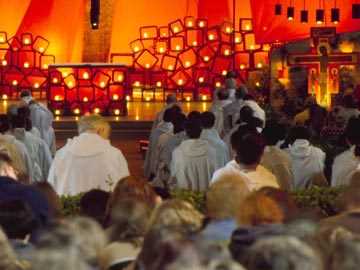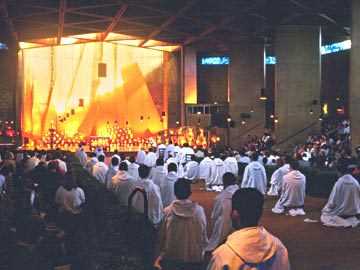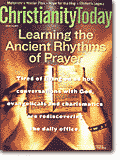As a result, they find themselves increasingly
disconnected and isolated from other believers. They are subjective; guided
by their feelings of the moment, they freely abandon prayer modes
(confession, praise, intercession). In the end, these Christians find
themselves increasingly disconnected from God.
This is part of my own prayer biography. In
adolescence, I was reasonably disciplined in prayer until my sister, my only
sibling, died of leukemia at age 17. This set off a huge faith crisis. At
times I had nothing to say to God or did not know how to voice my prayers.
About two decades ago, on a whim, I bought a
discontinued book by a famous Catholic priest. As a convinced evangelical
Anabaptist, I was skeptical. But I was also curious. As it turned out, this
book became the starting point in my recovery of a fuller prayer life
through the daily office.
I've not been alone in this discovery, as my visits
to a number of prayer communities quickly showed.
"The holiest place in all of England"
My first stop was the island of Lindisfarne (locals prefer "Holy Isle"). Its
small village includes several churches and three retreat houses—Lindisfarne
is possibly one of the few places in Great Britain where retreat houses
almost equal the number of pubs.
Lindisfarne has been an important pilgrimage
destination for centuries. From it sprang much of the early evangelization
of England. Numerous Celtic Christian saints are associated with it, as is
the gloriously illustrated Celtic manuscript, the eighth-century Lindisfarne
Gospels. Alcuin, the medieval scholar and archbishop, once told Charlemagne
it was "the holiest place in all of England."
Today 140,000 people visit St. Mary Virgin Church
(now Anglican) each year. As the island's oldest building, its architecture
reflects Saxon and Norman influences, parts of it preceding the 12th
century. Behind it lie the ruins of an 11th-century Benedictine monastery.
St. Mary's also attracts visitors because its
pastor, David Adam, is the popular author of more than a dozen books of
Celtic Christian poem-prayers, including an office, The Rhythm of Life
(Morehouse, 1996), which Adam wrote because so many people, including
Anglicans, are unfamiliar with the office. Its short prayers and Scriptures
can be memorized quickly, so those who use it can be nourished at all times
and places. This office is getting around. Anglicans in the South American
Andes are translating it into Spanish. Non-Anglicans elsewhere also use it,
including a U.S. Navajo group and a group of Lapps in northern Finland.
Adam says an office is like lined paper: "If you
haven't got lines on the paper, you can't achieve much by yourself," he
says. "That is true of most people: if they're left without an office,
without prayers they learn and recite, they tend to pray very little."
The office helps us pray when prayer is hard. He
says that during spiritually dry or discouraging periods, "you've actually
got this resource within you which you can call on. Even if you may have to
say it quite coolly, you can still say it. I compare it to my wife's
cooking: even when she's not that fond of me, she still cooks for me."
Regarding the modern aversion to repetition, he
says, "It's really hard to get people to see that what you're dealing with
is something of tremendous depth, and the words are just plumbing the depth.
It's. … like turning a drill. It might appear boring, but the more you are
turning the deeper you get. It's literally boring. But if you only turn it
once you don't get very far.
"I suppose most folks who don't like repetition
never say 'I love you' to their wife more than once in their life," Adam
says, laughing.
But Adam recognizes obstacles: "Offices were written
for people who had a more leisurely start to their day. Nowadays most people
set an alarm, jump up, and travel miles and are in a hurry. The office says.
… 'Slow down, take your time. Make some space.'"
Another problem is finding times and places to meet
with others. The office requires community: "Any office by yourself for long
is difficult. Even if you share the office once or twice a week, you can
manage it the rest of the time by yourself—as long as you have this
sharing," Adam says.
Adam has a pastoral and missionary concern for
island neighbors and the visitors who come from all over the world. He meets
many and offers counsel, support, and advice. Adam's ministry confirmed
something I saw in each community: people are drawn to prayer and a
community rooted in the office.
Prayer echoing off stone walls
Iona is a small Hebridean island off Scotland's west coast. Columba, an
Irish monk, landed there in the sixth century, setting up a monastery that
evangelized much of Scotland, England, and Europe. A burial place of many
Irish and Scottish kings, the monastery is known for a beautifully
illustrated Celtic manuscript, The Book of Kells. The sense of
history is reinforced by the ancient gravestones and standing stone crosses
(one is more than 1,000 years old) found on the island. Samuel Johnson once
wrote that a person "is little to be envied whose piety would not grow
warmer among the ruins of Iona." It is a stunning place with stark hills,
huge boulders, snow-white beaches, and many-hued waters.
In the 1930s, Church of Scotland (Presbyterian)
clergyman George MacLeod gathered seminary students and tradesmen to rebuild
the ruined medieval Abbey. This project, which was designed to help
ministers understand working folk and to train working folk in theology, was
the beginning of Iona Community. Now with more than 200 members from many
denominations, and growing steadily, the community has a strong commitment
to peace and justice and is known for its worship resources. Its island
conference centers are so popular that reservations must be made months in
advance.
The abbey sees more than 100,000 tourists per year
(sometimes up to 1,200 a day). This is especially impressive since it is no
mean feat to get there: from Glasgow, one must take a train, two ferries,
and a bus that crosses the Isle of Mull on a one-lane road. People joke that
it is easier and quicker to get to Spain.
I stayed a week at the abbey. Guests, staff, and
volunteers from around the world represented many denominations. In addition
to daily morning and evening prayers, there was strong emphasis on community
and chore-sharing. (Each day I proceeded from morning prayers to clean
toilets while humming hymns.) Worship and work are integrated. Morning
worship never ends with a benediction—as work is part of worship—and the
evening service never begins with a call to worship, since it is an
extension of work.
Worship was lively and inspiring. We said the Lord's
Prayer rhythmically, phrase by phrase, each line echoing against the stone
walls like the waves beating on rocks a few hundred feet away. Our singing
included praise choruses, hymns, African-American spirituals, monastic
chants, and international Christian music—all with the magnificent acoustics
of the rebuilt medieval church.
Iona encouraged prayer in many ways. The main church
has a special corner for intercession and healing, and Iona offers a healing
service once a week. The abbey had other chapels dedicated to prayer. In the
main church, a little shrine calls to mind "all victims of violence in the
world and those who stand with them." One transept, behind a screen donated
by Queen Elizabeth, is filled with displays about a host of social and
political movements, including human rights (Amnesty International),
international debt relief (Jubilee 2000), and opposition to land mines.
Iona believes that worship needs to be incarnational,
engaged with daily life, and historical, rooted in Christian traditions.
Daily prayer—even if not in a shared space—is important for holding the
dispersed community together. "Whatever our mood, whatever our
circumstances, there's a given," says Norman Shanks, Iona's leader. "If you
like, it is a gift." That gift gradually transforms Christians, he adds,
helping us at all times to be still, silent, and open to God and others.
Brian Woodcock, a United Reformed pastor and Iona's
warden (administrator), is concerned for those with little church connection
and finds it important to emphasize the Bible in every service. Youth often
comment that the services are not "boring" like some church worship. Often
people who do react to the repetitiveness early in the week welcome the
rhythm by week's end.
A perennial problem for retreat places is that
"mountaintop experiences" do not connect with life. Woodcock says worship
needs to help people remember that "if we come away in order to find God, in
the end it isn't God that we're finding." Withdrawal must always have the
purpose of changing our perspective and helping us engage where we live,
work, and minister. Several times I heard a wry quote: "People come seeking
peace and quiet, and we try to send them away seeking peace and justice."
Shanks said that Iona involves "renewing,
reconciling, living, and exporting the gospel in engagement, not withdrawing
to the margins of a ghetto or a supposedly peaceful place." As visitors are
told before afternoon prayers: "The gospel commands us to seek peace founded
on justice."
The most difficult thing about prayer is its
challenge. "If one takes the actual words quite seriously, some of it is
quite hard," Shanks says. "The God reflected is a God whose love is
compassionate and steadfast but also tough. The morning office promises, 'We
will not offer to God offerings that cost us nothing.'"
Refugee camp around a church
At Taizé, the only impressive building is the church. A Methodist minister
told me that Taizé looks "like a refugee camp built around a church."
("Refugee camp" is appropriate since it seems that people came to Taizé
seeking refuge from a secular and materialist culture.) For one older woman,
the camping, food lines, and crowds brought flashbacks of her internment in
a World War II concentration camp.
Each day is organized around three worship
services—morning, noon, and evening—each lasting an hour. People sit or
kneel in a darkened room, facing ceiling-to-floor banners, hundreds of
flickering candles, and icons. Music is led by an unseen song leader and a
volunteer choir. Each service is a series of Taizé chants, short Bible
readings (especially Psalms and Gospel readings), prayers (translated into
four to six languages), and a prolonged silence of five to ten minutes (no
mean feat with thousands of youth). This is a far cry from the beachball
pyrotechnics at our denominational youth events. The emphasis is on
simplicity (especially necessary given different language groups and church
traditions) and evoking mystery and reverence.
The singing was so beautiful that for the first time
in my life I was attracted to the idea of singing in heaven for all
eternity. When the evening service ended at 9:20, many opted to sing and
pray for hours more, often past midnight. People still lingered at 1:30 a.m.
after the weekly Friday-night vigil.
In addition, the day includes hour-long Bible
studies (also translated into many languages), chores, and common labor—not
your typical holiday jaunt.
Many people return year after year. Months after my
visit, some of those who have kept in touch with me continue to speak about
how the week was a turning point and marked a deeper commitment to prayerful
service.
Roger Schutz-Marsauche (now Brother Roger) founded
Taizé during World War II. Coming out of a Reformed background, he hoped to
create a small, prayerful community to reconcile Christians. As more and
more visitors came, the brothers responded to the spiritual hunger. In
response to the influx of youth, the community simplified its traditional
monastic worship, using short texts, prayers, and repetitive chants. Of all
the communities I visited, Taizé is the most radical in its willingness to
revise its daily office; indeed, Taizé leaders no longer use the term
office and prefer common prayer.
"The concern. … is that people can understand
something of the Christian mystery," says Brother Emile. "I've often thought
about a professor who spoke about how he had changed. He said, 'I used to
teach with the conviction that if my students didn't understand what I was
saying, they would come and ask questions. Now I see that's not how it is.
No, if they don't understand, they go away.' He says, 'It's when they do
understand something they start to ask questions.'
"That's one of the concerns here," Brother Emile
says, "that people can quite quickly understand something of what's at the
heart of the Christian mystery. If they understand that, then they'll want
to go further, start to ask questions: How can I deepen the faith? How can I
get to know the Scripture more? That has guided a lot of what we do here."
Where the great streams converge
The least famous place I visited was where I felt most at home, at the
Northumbrian Community. Its symbolic center is Hetton Hall, an old, rambling
house in remote, rural northern England, built around an 13th-century tower.
The publishing giant Harper got hold of
Northumbria's office several years ago, and sought permission to publish it.
Celtic Daily Prayer (Harper, 1994) has sold well and people have come
from as far away as Tasmania and Russia to visit because of it. Northumbria
is surprised at the wide response.
While I was there, middle-aged and elderly women
were attending an art retreat led by "Christian Goths." Recent guests and
volunteers include people from the United States, Canada, France, and
Australia. The community property includes a prayer chapel and two
poustinias (outdoor prayer cells). The community prays together four times
daily: morning, noon, evening, and before going to bed. Singing includes
hymns and choruses. The services have a set structure but include times for
spontaneous sharing and intercessions.
Conversations included references to Youth With a
Mission, Youth for Christ, Baptist churches, the Vineyard movement,
spiritual warfare, and Spring Harvest (a major annual evangelical festival).
At the same time, there are icons everywhere and crossing oneself is a
regular part of prayer. The community is enriched by all Christian
traditions. Richard Foster "believes our community is a living embodiment of
his book, Streams of Living Water," says Trevor Miller, one of the
community's two leaders.
Members spoke of their "new monasticism." Like the
other communities, they feel a call to minister to those who feel estranged
from the established church. Northumbria members put strong emphasis on
intercession. I was a beneficiary. While at Northumbria, I learned that a
good friend in Canada—a 45-year old husband, father, and psychiatrist—had
been hit by a car and was on life support. Community members prayed for him,
his family, and me.
A middle-aged mother of teenagers said she
appreciated the emphasis on "grace and struggle" since "triumphant and
victorious living" rhetoric was no longer helpful for her. A Baptist member
found liturgical worship foreign, but saw that it affirmed God's presence in
new ways and involved "other truths I need to hear." She appreciated the
connection with other Christian traditions. David Ward, a charismatic
evangelical pastor, wrote for a Northumbria newsletter about his discovery
that the daily office gives more depth to his prayer life and functions as a
school of prayer.
Community member Rob Brown told me that even
nonliturgical people find "anchors" in the office: "For people in deep
struggles, to have something that happens every day at the same time, it's
like a skeleton that keeps them from falling to pieces."
Ceaseless praise
The daily office is not easy and it will not solve all problems. As Brother
Emile says, "No matter how beautiful a prayer is, there's always going to be
a need for perseverance, for commitment, for being faithful. There will be
times when we don't feel the beauty. Then we pray the question rather than
what we feel."
But even and especially then, Emile notes, we need
to pray together: "People are not going to be able to persevere alone
in personal prayer. In regular common prayer, you join together and take
your part. Discouragement is too easy today. But in common prayer you
support one another. We are never all at the same place. … This week I
support you and next week I need your support."
The point is not a new works righteousness or
meaningless formality. Rather, this practice can provide a way of prayer
that will help some—perhaps many—pray. St. Benedict wrote of singing Psalms
"in such a way that our minds are in harmony with our voices." The daily
office can integrate life and prayer in just this way.
Or, to paraphrase a great old hymn, this might just
be the way for God to "take our moments and our days; [and to] let them flow
in ceaseless praise."
Arthur Paul Boers is pastor of
the Bloomingdale (Ontario) Mennonite Church. His latest book is Never
Call Them Jerks: Healthy Responses to Difficult Behavior (Alban). His
research was made possible in part by a grant from the Louisville Institute
(a Lilly Endowment program)



